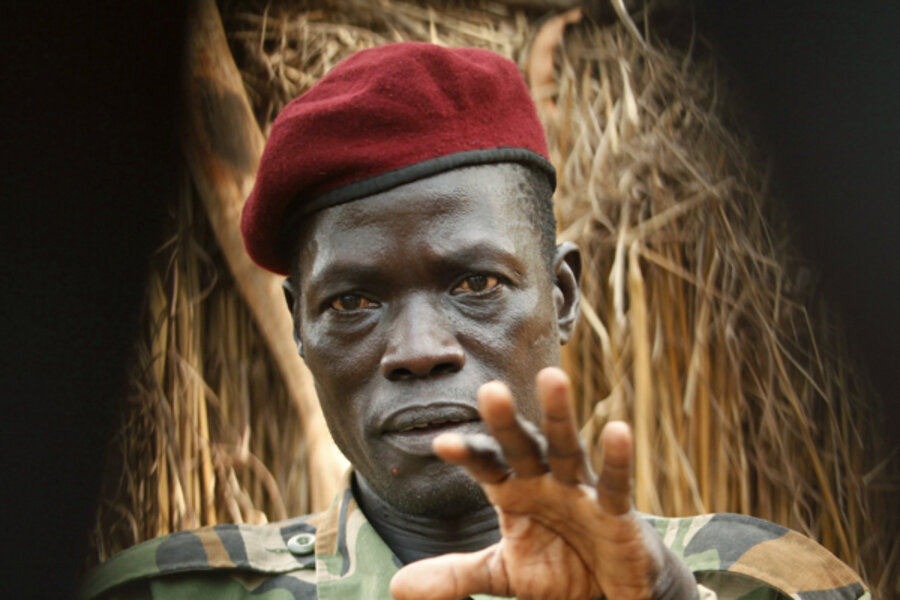Kony hunt: Ugandan army captures senior LRA commander
Ugandan troops have captured a senior commander of the rebel group the Lord’s Resistance Army, a group that has led a bloody rebellion against the Ugandan government for more than 20 years and gained international notoriety with the recent "KONY2012" viral video.
Caesar Acellam is thought to be the fourth highest commander in the LRA, under Joseph Kony. At the time of his capture on Saturday morning, he appears to have split away from a larger group of LRA fighters, apparently over a dispute. He had just one AK-47 rifle and eight rounds of ammunition, and was accompanied by his wife, a daughter, and a helper.
"The arrest of Major General Caesar Acellam is big progress because he is a big fish," said Felix Kulaigye, the Ugandan army spokesman, at a press conference announcing Mr. Acellam’s capture. "His capture is definitely going to cause an opinion shift within the LRA."
The capture of Acellam (the spelling of his name confirmed by the AFP's Max Delany, who also writes for the Monitor) is a huge success for the Ugandan-army-led operation against Mr. Kony’s LRA, which has killed and maimed thousands, conscripted at least 60,000 child soldiers, and displaced as many as 2 million people over the past 20 years. Originally started as a rebellion of the northern Ugandan Acholi people against the southern-dominated government of President Yoweri Museveni, the LRA turned into a proxy militant group for hire, whose current mission seems to be simple survival.
Uganda’s army, the Ugandan People’s Defense Force is backed up in its anti-LRA operation by 5,000 troops from South Sudan, the Central African Republic, and the Democratic Republic of Congo. The United States has contributed 100 Special Operations Forces as trainers in counterinsurgency and communications, as well as access to spy aircraft with the capability of sensing rebel troop movements under jungle canopy.
A blow to LRA's resolve?
Quoted by Mr. Delany of the Agence France Presse, Acellam predicted that his “coming out” would weaken the resolve of the few hundred LRA members still in the bush with Kony.
"My coming out will have a big impact for the people still in the bush to come out and end this war soon," Acellam told reporters brought by the Ugandan Army to the Central African Republic for the press conference.
The fight against Kony has been gathering pace, pushed along by an ambitious public campaign by human rights organizations such as Invisible Children. Earlier this year, Invisible Children targeted young Americans with a video called “KONY2012,” using social media such as YouTube, Facebook, and Twitter to make Joseph Kony one of the world most famous men, and to pressure international organizations to seek Kony’s capture.
Kony increasingly erratic
Defectors from the LRA say that the Ugandan-led operation has forced Kony to stay on the run, moving nearly every day. Abu Moussa, the UN representative to the Central African Republic, told reporters this week that defectors say Kony has begun acting increasingly erratically.
"People who have defected have provided information on his state of mind. Kony is no longer "very, very stable," said Mr. Moussa, who is helping to coordinate the international hunt and get more governments to try to trap Kony.
While Kony’s force is dwindling, the group’s capacity to attack civilians is undiminished. In the first months of 2012, LRA forces carried out 53 attacks, abducting 90 civilians and killing nine others, according to Human Rights Watch and the United Nations. The attacks are an increase over the number of LRA attacks reported in 2011.
“The increase in LRA attacks shows that the rebel group is not a spent force and remains a serious threat to civilians,” said Anneke Van Woudenberg, a senior researcher at Human Rights Watch.
Get daily or weekly updates from CSMonitor.com delivered to your inbox. Sign up today.





